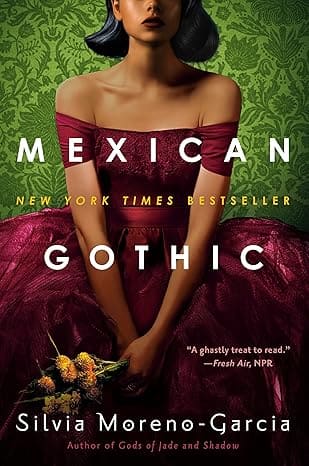
Synopsis:
An isolated mansion. A chillingly charismatic aristocrat. And a brave socialite drawn to expose their treacherous secrets…
After receiving a frantic letter from her newly-wed cousin begging for someone to save her from a mysterious doom, Noemí Taboada heads to High Place, a distant house in the Mexican countryside. She’s not sure what she will find—her cousin’s husband, a handsome Englishman, is a stranger, and Noemí knows little about the region.
Noemí is also an unlikely rescuer: She’s a glamorous debutante, and her chic gowns and perfect red lipstick are more suited for cocktail parties than amateur sleuthing. But she’s also tough and smart, with an indomitable will, and she is not afraid: Not of her cousin’s new husband, who is both menacing and alluring; not of his father, the ancient patriarch who seems to be fascinated by Noemí; and not even of the house itself, which begins to invade Noemi’s dreams with visions of blood and doom.
Her only ally in this inhospitable abode is the family’s youngest son. Shy and gentle, he seems to want to help Noemí, but might also be hiding dark knowledge of his family’s past. For there are many secrets behind the walls of High Place. The family’s once colossal wealth and faded mining empire kept them from prying eyes, but as Noemí digs deeper she unearths stories of violence and madness.
And Noemí, mesmerized by the terrifying yet seductive world of High Place, may soon find it impossible to ever leave this enigmatic house behind.
Review:
Filled with unexpected twists and a nebulous brand of danger, Mexican Gothic is a dark and disturbing tale—and well worth a read.
The main character is Noemí Toabada, a young socialite who spends half of her time at parties and the other half in school, studying anthropology. She was an interesting character, both vain and keenly intelligent, loyal to her family, yet at times, she was also self-serving. Noemí had a stronger constitution than she appeared to possess at first, making her an unlikely heroine. But she was the hero of this story, and I liked her when I didn’t initially think I would.
After she was sent to check on her cousin at High Place, Noemí began to experience what she at first believed were nightmares. The dreams were merely strange at first, but slowly became more eerie and terrifying. She didn’t understand the cause at first, but with subtle hints from her cousin, who Noemí was only allowed to see sporadically (and under strictly controlled circumstances), Noemí started to unravel the mystery surrounding High Place and its reclusive inhabitants.
Uncovering that mystery is central to the story, but it took some turns I wasn’t expecting. At first, the weird occurrences Noemí experienced felt like a classic haunted house tale—her nightmares and subsequent sleepwalking, the half-seen movements she glimpses around the house, and the general strangeness of the Doyle family who lives there. But midway through the book, a scientific explanation for everything is revealed.
I really, really want to talk about that explanation in detail, but I can’t without going into some major spoilers. What I can say is this: It made sense and it worked for this story. I will admit to being slightly disappointed that this wasn’t actually a ghost story, however. It was still plenty creepy and there were more disturbing scenes in store, and I know my reaction was due to my own scientific background. I personally don’t find the thing at the heart of this story that scary (though I know plenty of people who will.)
Aside from Noemí, there are a few other characters worth noting. Her cousin, Catalina, was the reason she went to High Place, but Catalina isn’t very present in the story until the end. Catalina was ill for much of the book, making her interactions with Noemí sparse. Most of the Doyle family were, for lack of a better term, horrible people (with one exception.) The family patriarch, Howard, was a lecherous old man, and Virgil (Catalina’s husband) was similar, but I felt his ick factor was even higher. After Noemí uncovers their secrets, their behavior makes sense in a twisted kind of way, but everything about them was still downright awful. The only likeable Doyle was Francis; he was quiet, unassuming, and sweet, but trapped in the same nightmare as Noemí and Catalina. I liked Francis.
Overall, I thought Mexican Gothic was a great book, and another excellent pick for my October reading list.












Leave a Reply